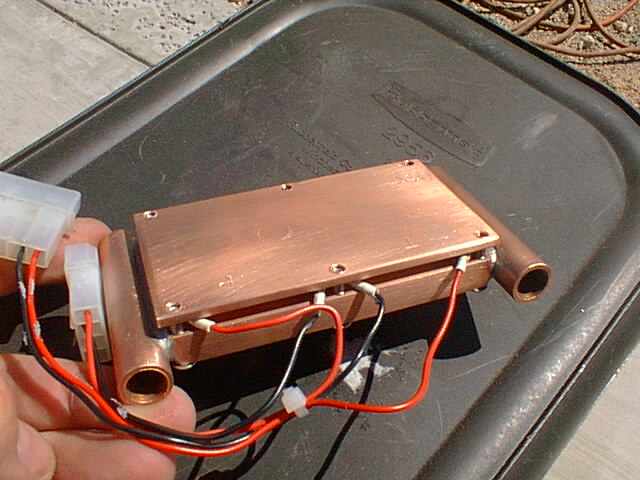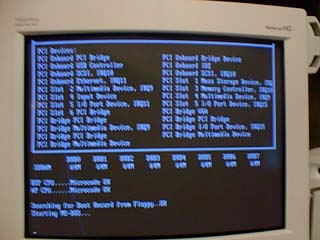Project Number 6
After much work and frustration, the fruits of the TYAN S1834D Tiger® motherboard have come to pass. Utilizing my phase change cooling system and modified cold plates epoxied directly to the 800 MHz PIII Coppermine® processors, 1155 MHz was achieved with stability and 1.2GHz was achieved for about one hour at a time. Failure to "overclock" above 1128MHz was caused by the memory. Anything over 142MHz on the FSB would lock up the system with more than one 128Meg module. After swapping the 4 pieces around and trying 9 other modules, I have found two that will work up to 145MHz and when I push to 150MHz, I can only use one. The key to the success of the project was the attachment of the cold plate to the CPU. Normally we use a "thermal grease" between the cold plate and the CPU core, but the area of contact is very limited due to the core size. After months of research, I found a thermally conductive epoxy from Epoxies, Etc., product no. 50-3100, which provided twice the thermal conductivity of the "silver greases" available today. It also allowed me to "bond" the entire chip surface to the cold plate, increasing the contact area by 575%. At 1.2GHz, I had to push the peltiers to 15.6V to drop the CPU temps down to minus 55C, but the amount of heat generated by the four peltiers would gradually raise the coolant temp and the CPU temp would rise and lock up the system. Under load (crunching 2 Seti@Home's), this would be about 55 minutes.


Jump to the Project Details page
The Results:


The system has evolved during that period of time because of the change in peripheral cards and the slow phase out of the ISA bus. Originally I was using a 7 slot ISA backplane, but now have changed to a 7 slot PCI backplane. Now on of the most challenging things about any "overclocking" project is the fact that most peripheral cards just don't like it. My system is full of PCI cards and IRQ assignments, resources and general conflicts start long before you can "crank it up":


Now it is very possible to "overclock" any Intel® Processor with adequate cooling, use good quality PCI cards in properly configured NT4.0 systems, and get very stable results, but you must plan, test, plan and then play. As of right now, I cannot get this system to run in WIN2000 because of "plug and play", it prevents the recognition of most of the PCI cards and tries to load PCI bridge drivers for the expansion board.
Dual AMD K-7 CAN'T WAIT
Right now the system is running at 1155MHz with the PIII Copppermines® and extremely stable. The only "Blue screens of death" have been caused by my determination to run Win98 games with NT4.0 SP6 on this machine. With the Directx5 hack for NT4.0, NT4DX5.ZIP, and NT4DX61.ZIP, (written for NT5.0 Beta 1 but works flawlessly on NT4.0), I have been successful with about thirty games. The Obsidian2 X-24, NTGlide ver. 2.54 and dual 1.16GHz PIII's makes for an incredible gaming machine.
Back to Home Page